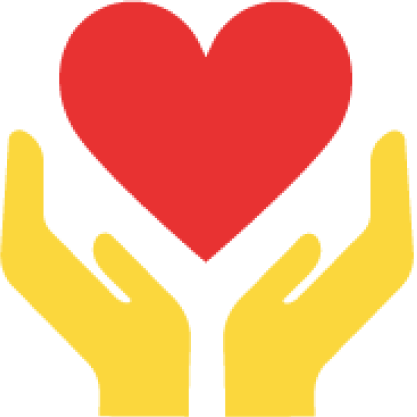Nonprofits
This playbook provides guidelines for Greater Des Moines (DSM) nonprofit organizations serving regional communities. Leaders are also encouraged to look at other playbooks for applicable advice from related industries and consult the professional playbooks for additional guidance and templates. Organizations may need to adapt specific steps outlined below according to their size and mission.
Sample: Nonprofit Thrift Store Risk Profile
The sample risk profile has been determined for nonprofit thrift stores in DSM. The profile shows frequency, or how many people in a day; duration, or length of typical interaction; and variety, or the number of different people.*
The coronavirus pandemic and the resulting economic shutdown has had significant effects on services, operations and the people working in the nonprofit sector. According to a COVID-19 impact survey conducted in early 2021 by the Iowa Economic Development Authority and the University on Northern Iowa, Iowa nonprofits reported that an average 24% of their clients will no longer be served or will receive reduced average monthly services. In addition, current/project demand for services in 2021 as compared to 2020 has increased by an average of 9.88% while projected income has deceased by an average of 0.58%. About half indicated no projected decrease was expected through June 30, 2021 due to financial assistance from private donors and philanthropic organizations/foundation. However, among those who did report shortfalls, the average was $261,149.11 with a median of $40,000. While the vast majority of not-for-profit organizations do not foresee permanent closure due to COVID-19 (93.0%), 3.7% anticipate closure could occur in 2022 or later.
|

|
Continuity Plans
Organizational continuity planning is a crucial component of a risk management strategy and is helpful in preparing for effective operations with reduced staff. Ensure your business continuity plans are up-to-date and block time to craft plans if they don’t yet exist. Helpful places to start include identifying your most essential activities, identifying which programs and resources could be discontinued or suspended, and mapping out how to communicate plans to external stakeholders. Continuity plans should also consider board management. Provisions during the crisis could allow for virtual meetings, smaller quorums, shorter meeting notices, etc. all elements of agility that might be needed if board members become incapacitated.
|
|

|
Recalibrate Programming
Understand how your programming and resources will need to be changed after COVID-19. Organizations that have the opportunity and means to serve clients through telework or virtual channels should develop these capabilities. Those who require a physical presence to deliver their services should identify what safety equipment or policies may now be required.
|
|

|
Remote Work Changes
Organizations may maintain a partially digital and remote workforce allowing them to repurpose physical space for new, value-added activities.
|
|

|
Digital Channels
Donors, clients, staff and community members may be used to experiencing your organization and its services in a physical setting. Ensure digital technology captures the “magic” you deliver to these constituencies via platforms such as Zoom, Google Hangouts, or WebEx which support effective communication to staff, clients and communities. Increasing investments in social media, website design and other media channels can help broaden your message to your audience.
|
|

|
Leverage Board Members, Leaders and Top Donors
Enlisting stakeholders closest to the mission could be helpful in mitigating funding loss due to COVID-19 and continue programming and resource delivery to clients. Enlisting executives, board members, and others greatly invested in the mission to support fundraising, communication, and even program delivery will help weather the storm created by COVID-19. See the Community Foundation of Greater Des Moines resource page (linked) below for more ideas, information and available resources.
|
|

|
Donor Partnerships
The pandemic response has brought donors together at the local, state, national and global levels to pool resources, align on priorities and deploy funds rapidly through collaborative funding platforms. When it comes to philanthropic giving, team up to combine expertise and drive efficiency rather than go at it alone.
|
|

|
Personalized Digital Donor Communication
Individuals overwhelmed with information are seeking authenticity and personal communication in a growing “attention economy.” Deepen engagement with donors and potential supporters through personalized communication and effective storytelling via digital channels. This effort can be accelerated through donor data analytics to determine which elements e.g., videos, testimonials, etc. are most effective.
|
|

|
Volunteer Management
Volunteer workforce shortage is impacting nonprofits that rely heavily on volunteers, particularly retirees who are at high risk of serious illness from COVID-19 and are not volunteering as a result. Such nonprofits may leverage partnerships to share volunteer workforce or develop new or additional virtual mechanisms by which volunteers serve remotely, or increase outreach to new potential pools of volunteers. The United Way of Central Iowa and Volunteer Iowa (see links below) can assist organizations who need assistance in this area.
|
|

|
Reduce Burden on Grantees
Seeking and managing grants can be a cumbersome process, especially for small, community-based organizations. The COVID-19 pandemic has prompted many foundations to relax grant requirements, speed up decision-making and give recipients additional flexibility in how they use funds. As the crisis abates, donors will consider whether it might be time for a sector-wide effort to ease nonprofits' administrative burdens.
|
|

|
Accelerating Spending
COVID-19 has prompted a number of donors to dig deeper into their endowments and deploy more capital than they had planned. Boards and leadership teams, as well as individual philanthropists, should plan on having discussions about the rationales for their giving horizons and consider permanently accelerating the pace and volume of giving.
|
|

|
Public Sector Support
The pandemic has brought philanthropic innovation to the forefront both in advance of and in conjunction with local and state agencies. Continue to collaborate with public-sector partners to support innovative programs, solve underlying programs and ensure recovery policies are responsive to community needs.
|
Health & Sanitation
- Conduct a health screening with all employees before their shifts in accordance with the most up-to-date recommendations from your local public health department.
- Encourage employees who feel sick to stay home. Employees who have had close contact with someone with COVID-19 should consult CDC guidance on when to self-quarantine.
- Train all employees on appropriate cleaning and disinfection, hand hygiene and respiratory etiquette.
- Face coverings and other PPE should be worn by employees and clients in accordance with the most up-to-date recommendations from the local public health department.
- Provide tissues and no-touch trash cans.
- Provide soap and water in the workplace. If soap and water are not readily available, use alcohol-based hand sanitizer with at least 60% alcohol. Ensure that adequate supplies are maintained.
- Ideally, place touchless hand sanitizer stations in multiple locations to encourage hand hygiene.
- Discourage workers from using each other’s phones, desks, offices or other work tools and equipment, when possible.
- Clean high touch surfaces and shared objects once a day.
- You may want to either clean more frequently or choose to disinfect (in addition to cleaning) in shared spaces if certain conditions apply that can increase the risk of infection from touching surfaces:
- High transmission of COVID-19 in your community
- Low number of people wearing masks
- Infrequent hand hygiene
- The space is occupied by people at increased risk for severe illness from COVID-19
- If there has been a sick person or someone who tested positive for COVID-19 in your facility within the last 24 hours, you should clean AND disinfect the space.
- Provide sanitizing materials so high-touch surfaces (e.g., pens, time clocks, break room tables and chairs, vending machines, railings, door handles) can be wiped down, as needed.
- Ensure your employees, volunteers and ambassadors know what they can do to protect themselves when serving clients and the community.
- Provide accommodations like specific schedules for vulnerable populations if possible.

Process & Space Modifications
- Implement measures to enable six feet of social distancing.
- Provide physical guides (e.g., guides for creating “one-way routes”) such as tape on floors or sidewalks and signs on walls to ensure that individuals remain at least six feet apart in lines and at other times.
- Install physical barriers, such as sneeze guards and partitions, particularly in areas where it is difficult for individuals to remain at least six feet apart. Barriers can be useful at reception areas, distribution counters, and other areas where remaining at least six feet apart is difficult.
- Use methods to physically separate employees in all areas of the facilities including work areas and other areas such as meeting rooms, break rooms, parking lots, entrance and exit areas and locker rooms.
- Arrange reception or other communal seating area chairs by turning, draping (covering chair with tape or fabric so seats cannot be used), spacing or removing chairs to maintain social distancing.
- Limit congregation in office spaces and non-essential worker interaction across floors, buildings, campuses, worksites, etc.
- Stagger arrival times or locations for meetings and events.
- Use flexible worksites (e.g., telework) and flexible work hours (e.g., staggered shifts) to help establish policies and practices for social distancing of at least six feet between employees, volunteers and others.
- Identify if there are appropriate ways to serve clients and community members through telework, virtual channels and volunteers.
- Limit attendance at events to allow for social distancing, or host smaller events in larger rooms.
- Prioritize outdoor activities where attendees can remain at least six feet from others not living in their household.
- If distributing items like food or supplies, consider using drive-up distribution so that people can maintain distance from each other and to eliminate the need to touch doorknobs and other items and surfaces in a facility.
- Consider temporarily suspending singing, chanting or shouting during events especially when participants are in close proximity to each other. If attendees choose to sing, chant or shout, encourage them to wear masks and increase distance between people to greater than six feet.
- Limit any nonessential visitors, spectators and volunteers at events.
- Limit activities involving external groups or organizations as much as possible — especially with individuals not from the local geographic area (e.g., community, town, city or county).
- Consider temporarily suspending musical performances that involve singing or playing wind instruments. If such events are held, musicians should be spaced as far apart as feasible, ideally farther than six feet apart.
- Ensure that groupings of staff, volunteers and program participants are as small and as static as possible. Consider:
- Scheduling staff and volunteers together in small groups (cohorts) so that they are always scheduled to work on the same days/times together, reducing their exposure risk.
- Ensuring attendees of regular events (e.g., support groups) are scheduled with the same group of attendees for each event so that individuals are in contact with the same people for each visit and so that distinct groupings do not mix.
- Limiting use of supplies and equipment to one group of people at a time and clean and disinfect between use.
- Ensure ventilation systems operate properly and increase circulation of outdoor air as much as possible, for example by opening windows and doors. Do not open windows and doors if doing so poses a safety or health risk (e.g., risk of falling or triggering asthma symptoms).
- To minimize the risk of Legionnaires’ disease and other diseases associated with stagnant water, take steps to ensure that all water systems and features (e.g., sink faucets, drinking fountains, decorative fountains) are safe to use after a prolonged facility shutdown.
- Drinking fountains should be cleaned and sanitized, but encourage people working in or visiting your facility to bring their own water, as feasible, to minimize use and touching of water fountains.

Communication
- Post signs in highly visible locations (e.g., at building entrances, in restrooms) that promote everyday protective measures and describe how to stop the spread of germs by properly washing hands and properly wearing a mask.
- Encourage staff and stakeholders who come to your facility or attend events sponsored by your organization to self-report to the designated COVID-19 point of contact if they have symptoms of COVID-19, a positive test for COVID-19 or were exposed to someone with COVID-19 within the last 14 days.
- Give accurate, timely, relevant and credible information to your clients, communities and stakeholders.
- Identify and address potential language, cultural and environmental barriers associated with communicating COVID-19 information to organization staff and stakeholders. Tailor information so that it is easily understood by various audiences and is available in a variety of languages and formats.

Private Sector Support
In mid-April 2020, Principal Financial Group launched Giving Chain which supplies communities here and elsewhere with everything from grocery gift cards to custom cupcakes. Recently, Principal and Young Women’s Resource Group delivered 50 gift baskets to local mothers and children containing activity kits and gift cards to local grocery stores and restaurants.
Leveraging Partners in Program Delivery
In late March 2020, Food Bank of Iowa and Cottage Grove Church partnered to meet the needs of DSM residents impacted by the COVID-19 pandemic. Cottage Grove serves as a distribution point to provide dry goods to members of the community and also solicits donations for dry goods. Other previous Food Bank Mobile Pantry Program members have been shifted to drive-through distribution facilities in light of COVID-19.
The Des Moines Area Regional Transit Authority (DART) is partnering with the Iowa Cancer Consortium (ICC), with guidance from the American Cancer Society (ACS), to provide reliable transportation options for cancer center patients who need transportation to reach their treatment appointments. DART is also collaborating with the Des Moines Area Religious Council (DMARC) to support meal delivery during a time of growing food insecurity throughout the community.
Protecting the Homeless
Melissa O’Neil, CEO, and her team at Central Iowa Shelter and Services began planning for the COVID-19 pandemic on February 3, 2020 before many other nonprofits and businesses. Their first task was to rapidly transfer individuals in the shelter who needed only a security deposit or first month’s rent. The majority of this project was supported by the Polk County Housing Trust Fund. Although the pandemic has required a huge effort from the staff, they also see it as a chance to change our community long-term. The state of Iowa will receive between $20 million and $40 million in federal stimulus money to address homelessness. O’Neil calls this their Ice Bucket Challenge. How could we use this as an opportunity to end homelessness in DSM? View the full story here.
Supporting Essential Workers
Consider offering gifts, discounts, or partnering with essential organizations. For example, Goodwill of Central Iowa, a local workforce organization and thrift retailer, ran a weekend fundraiser for Central Iowa Shelter and Services to provide necessary goods to homeless citizens in DSM prior to the shutdown in March.
Engaging Central Iowans Virtually
Due to temporary furloughs and layoffs, some community members are seeking volunteer opportunities while ensuring proper safety and sanitation. For example, Everybody Wins Iowa! asked supporters to record videos reading children’s books aloud and has transitioned to an online delivery model to deliver online reading to their community.
Recommended Playbooks
The business function playbooks include takeaways that are specific to professional functions that could be present in any business, regardless of industry.
*We note that these assessments are qualitative and based on expert-led judgment (Johns Hopkins, 2020). Currently, there are not enough detailed data available to enable quantitative risk stratification. Businesses will need to make decisions about re-initiating business activities before there are validated data to know the precise levels of risk.
Legal Disclaimer
The Greater Des Moines Partnership's DSM Forward playbook is
not intended to constitute legal advice or provide specific direction. The preparation of a business continuity or preparations plan should be undertaken with the advice and direction of appropriate specialists and personnel, in consideration of the unique circumstances impacting each business. Third-party websites or material linked to or referenced in DSM Forward are for informational purposes only and do not constitute a recommendation of The Partnership of that material or its authors.
Last updated: 5/18/2021